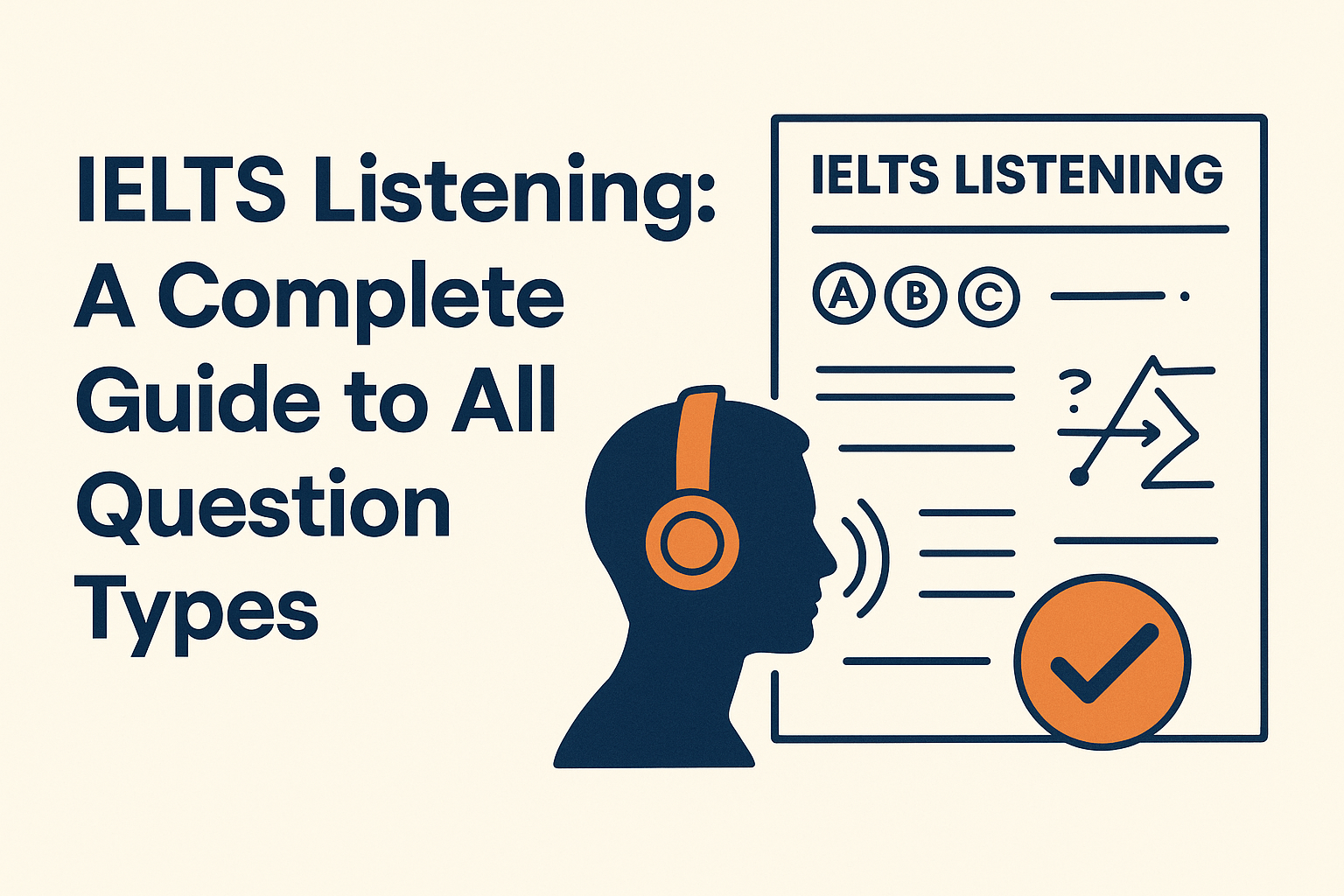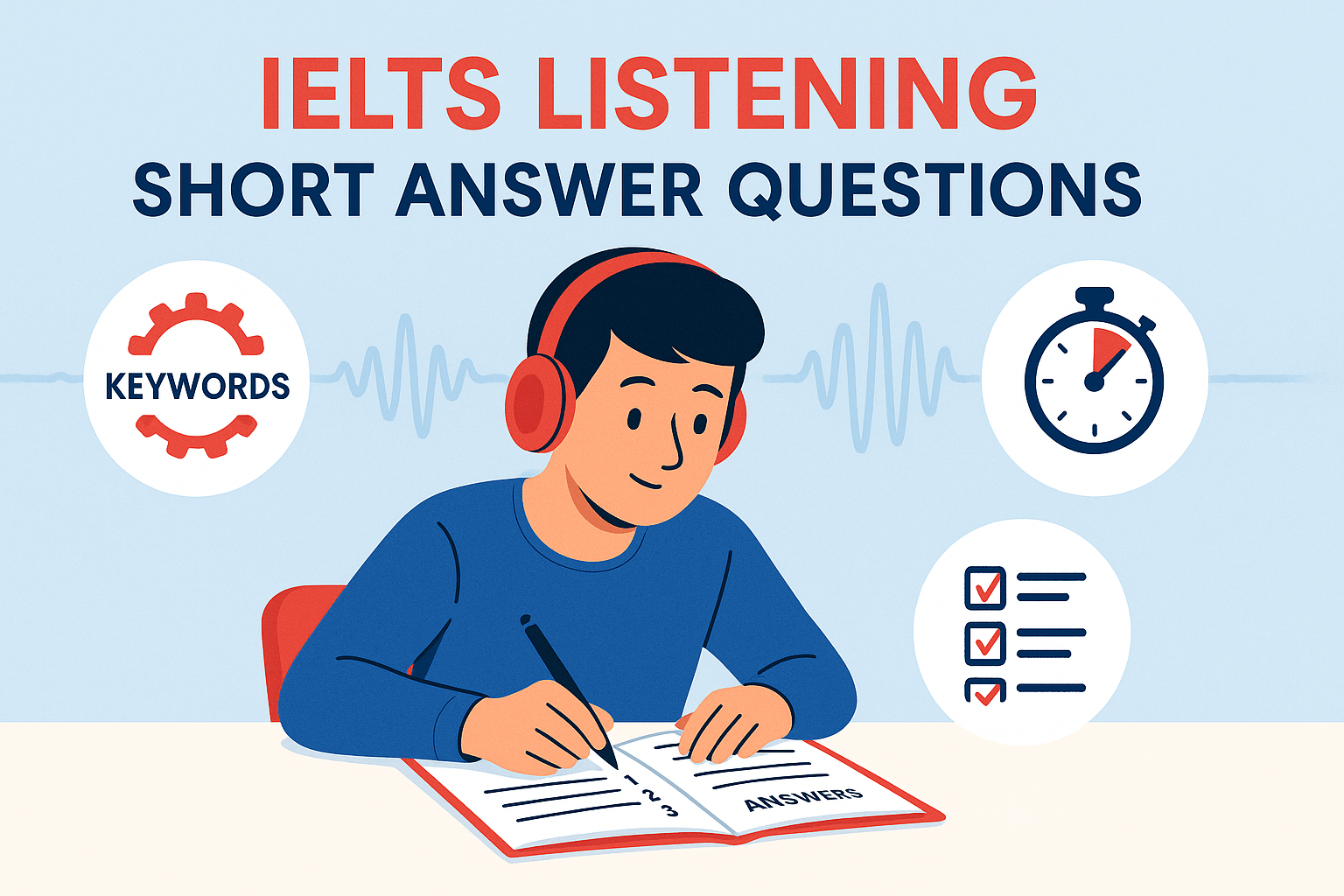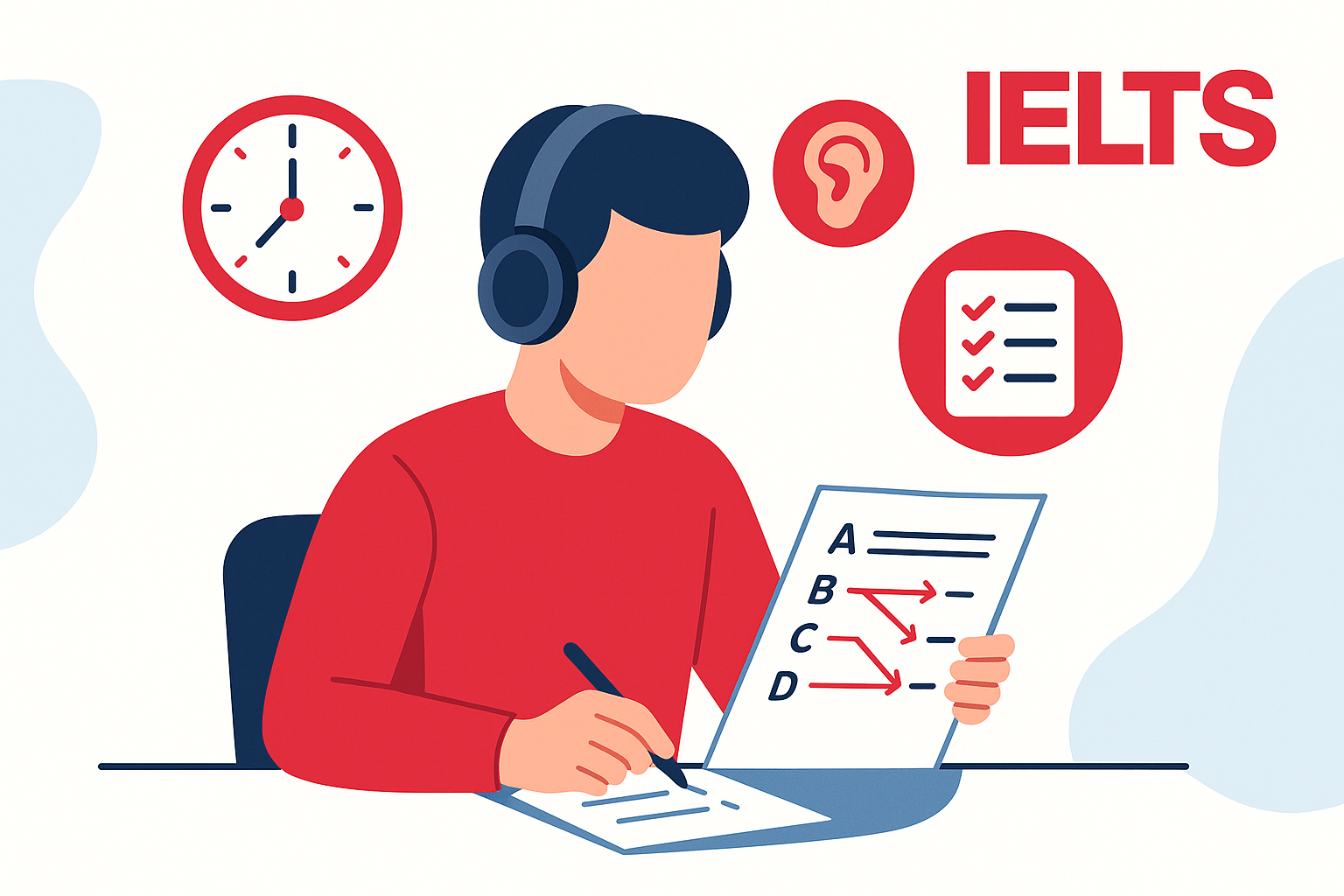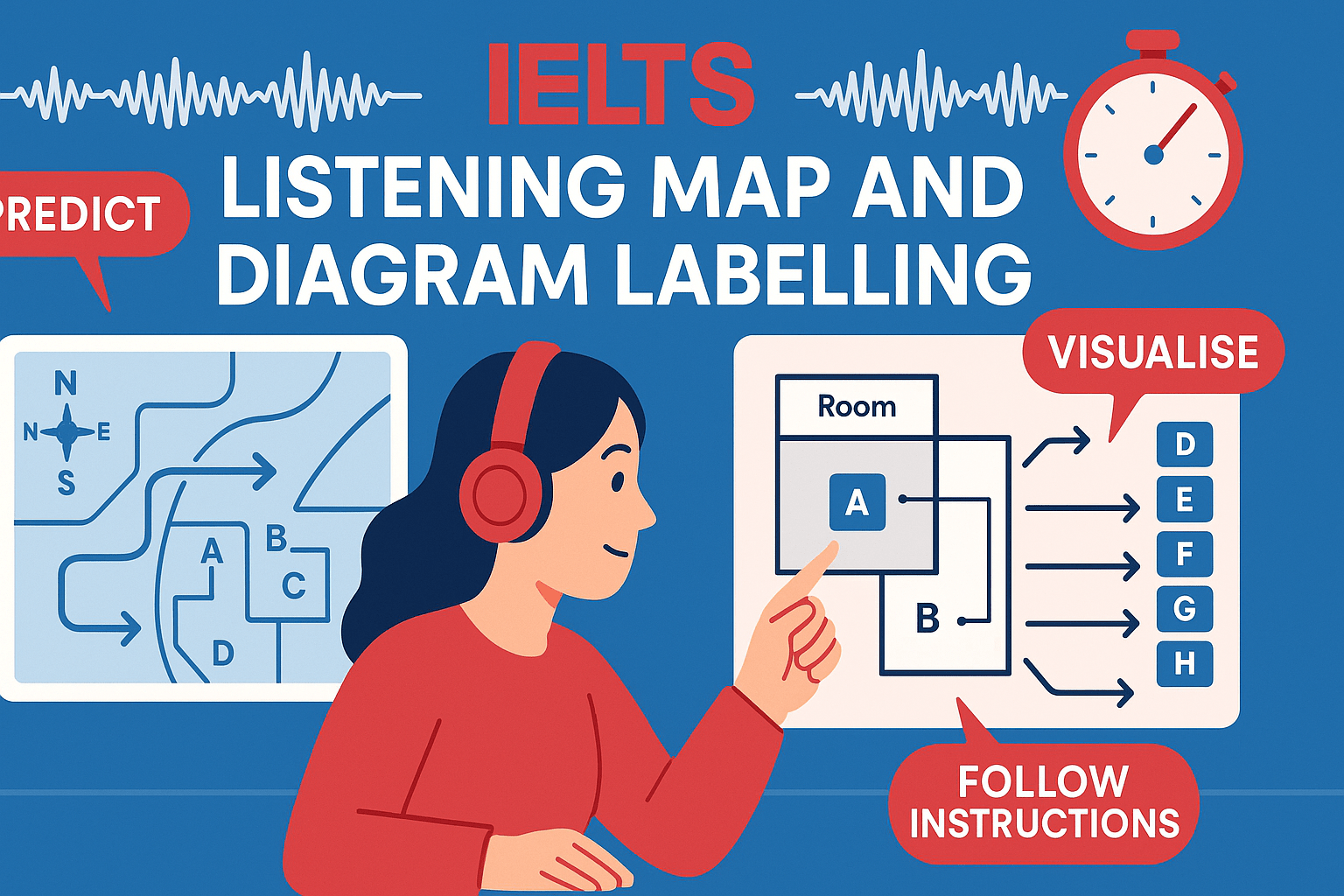Let me tell you something I’ve seen again and again:
Students who understand English really well still lose marks in the IELTS Listening test. Why?
Because they don’t know how the IELTS Listening question types actually work.
Take my student Fatima.
She was confident with grammar, had strong vocabulary, and watched English shows all the time.
But her Listening score wouldn’t go above Band 6.
When we looked closely, it wasn’t her listening skills that were the problem — it was the types of questions she didn’t understand fully. She’d rush through multiple choice, miss keywords in sentence completion, or panic during map questions. Once we fixed that, she jumped to a Band 7.5 in just two weeks.
Here’s what I want you to remember:
Each IELTS Listening question type is different.
It tests different skills.
It follows its own logic.
And it has its own set of traps.
If you don’t know how to handle each one, you’ll get caught — even if you understand every word in the recording.
But when you do know the types and the tricks? Everything changes. You stop guessing. You start listening with focus. And your score improves — fast.
In this blog, I’ll walk you through:
-
Every IELTS Listening question type, one by one
-
What to expect, what to avoid, and how to answer smartly
-
A real example from another student (Riku!) who made a simple but powerful shift
-
Practical strategies you can start using today
Let’s start by quickly looking at how the IELTS Listening test is structured — and why that matters before you even press play.
What Is the IELTS Listening Test?
Before we dive into the question types, let’s make sure you’ve got a clear picture of how the IELTS Listening test actually works.
A lot of students jump straight into practice without fully understanding the format — and that’s like playing a game without knowing the rules. So here’s what you need to know.
🕒 The Basics
-
The test lasts about 30 minutes
-
There are 4 sections (or “parts”)
-
You’ll hear 1 audio recording per section — only once
-
You’ll answer a total of 40 questions
-
At the end, you get 10 minutes to transfer your answers to the answer sheet
The recordings include a mix of accents (British, Australian, American, etc.) and a variety of settings:
-
Everyday conversation
-
Educational discussion
-
Monologue (like a university lecture)
-
Guided talk (like a tour or instruction)
So you’re being tested not just on what you hear, but on how well you can follow different speakers, tones, and contexts.
🔍 What Skills Are Tested?
The IELTS Listening test checks whether you can:
-
Catch specific details (e.g., dates, names, prices)
-
Understand main ideas
-
Follow the order of information
-
Spot attitudes or opinions
-
Recognise changes or corrections mid-sentence
Think of it like this: you’re not just listening — you’re tracking, decoding, and predicting what’s coming next.
📝 How Is It Scored?
Each correct answer = 1 mark
Your raw score out of 40 is converted to a Band Score.
Here’s a rough guide:
| Correct Answers | Band Score |
|---|---|
| 35–39 | 8.0–9.0 |
| 30–34 | 7.0–7.5 |
| 23–29 | 6.0–6.5 |
| 16–22 | 5.0–5.5 |
The good news? You don’t lose marks for wrong answers. So you should always attempt every question — even if you’re unsure.
💬 Quick Tip from Me
Treat each part like a different listening challenge. Don’t use one approach for every section — especially when the question types change.
🎧 All IELTS Listening Question Types – Explained Simply
Let’s break this down together.
There are 8 common IELTS Listening question types — and each one tests a different skill. Once you know the style, the traps, and how to listen for the right thing, you’ll feel more in control of the test.
We’ll go through them one by one, with:
-
What it looks like
-
What to listen for
-
Common mistakes
-
A quick strategy tip
🔹 1. Multiple Choice Questions (MCQs)
What it looks like:
You’ll hear a recording and choose the correct answer from 3 or 4 options.
What to listen for:
The speaker’s main idea, specific opinion, or a decision made.
Common mistake:
Students hear the first option mentioned and choose it — even though the speaker changes their mind later!
Quick tip:
Listen until the end of the sentence or conversation. The correct answer is often said after a false start or distraction.
🔹 2. Matching
What it looks like:
You match a list of items (like names or days) with options from a box.
What to listen for:
Descriptions, preferences, or details that help match the right pair.
Common mistake:
Rushing the match before hearing all the options.
Quick tip:
Read both lists carefully before the audio starts. Underline keywords and be ready to spot synonyms in the audio.
🔹 3. Sentence Completion
What it looks like:
You complete a sentence using a word or short phrase from the recording.
What to listen for:
Key information that finishes the sentence logically and grammatically.
Common mistake:
Writing the wrong form of the word — or including extra words.
Quick tip:
Follow word limits! If it says “No more than TWO words”, writing three = zero marks.
🔹 4. Form Completion
What it looks like:
You fill in the blanks of a form (e.g., a booking form, registration form).
What to listen for:
Basic facts like names, numbers, dates, prices, times.
Common mistake:
Missing small but important details (e.g., spelling a name wrong or using the wrong date format).
Quick tip:
Familiarise yourself with how British people say letters and numbers — “double,” “oh,” and months in particular.
🔹 5. Table / Flowchart / Summary Completion
What it looks like:
You complete a table, process diagram, or summary using words from the recording.
What to listen for:
Sequence, process, or step-by-step details.
Common mistake:
Not following the order of the table or summary — then losing your place in the audio.
Quick tip:
Always look at headings and keywords before the recording starts. They help you predict what’s coming.
🔹 6. Note Completion
What it looks like:
You fill in lecture-style notes on a topic.
What to listen for:
Facts, examples, and definitions.
Common mistake:
Trying to write down too much and missing key words.
Quick tip:
Only write what’s needed to complete the meaning — not full sentences.
🔹 7. Map / Plan / Diagram Labelling
What it looks like:
You label a diagram, building layout, or map using a given list of words.
What to listen for:
Directions, locations, and movement words (e.g., “go past,” “next to,” “opposite”).
Common mistake:
Getting lost while trying to follow the speaker’s description.
Quick tip:
Familiarise yourself with map language. Practice listening for spatial words and imagine the route in your head as you listen.
🔹 8. Short Answer Questions
What it looks like:
You answer questions using a few words or a number, directly from the recording.
What to listen for:
Direct answers — often simple facts or short explanations.
Common mistake:
Writing full sentences when only a phrase is needed.
Quick tip:
Scan the questions before listening and underline wh- words (who, what, where, etc.). These guide your focus.
🎯 Quick Reminder:
Always check the instructions and word limits before answering. It sounds simple, but many students lose easy marks this way!
Each of these question types is manageable — once you know what to listen for.
But what if you’re still struggling? You’re not alone.
👉 In the next section, I’ll introduce you to Riku, one of my students who faced the exact same challenges — and how he overcame them.
👨🎓 Real-Life Student Struggle: Why Riku Couldn’t Break Band 6.5
Riku was one of the most dedicated students I’ve ever worked with.
He watched English videos every night, took notes during practice tests, and reviewed vocabulary daily. But no matter how hard he tried, his IELTS Listening score stayed stuck at 6.5.
When we finally sat down to review one of his mock tests together, it didn’t take long to spot the issue.
🎧 The Problem Wasn’t His English — It Was the Question Types
Riku understood the recordings just fine. He could repeat back details and explain the main ideas. But when it came to certain question types, things started falling apart.
-
With matching questions, he got confused when similar options were mentioned.
-
During map labelling, he’d lose track of directions halfway through.
-
For form completion, he missed numbers and dates — or spelled names wrong.
He was trying so hard to catch everything, that he missed what mattered most.
💡 What I Told Him
I said, “Riku, you don’t need to listen harder — you need to listen smarter.”
He looked confused, so I explained:
“You already understand English. But IELTS isn’t testing your understanding in general — it’s testing whether you can handle the format. Each question type is its own mini-game. You’ve got to learn the rules.”
🧭 What We Did Next
We slowed down.
Instead of taking full tests, we focused on one question type at a time.
For each one, we:
-
Studied the instructions
-
Reviewed common traps
-
Practised short clips focused on just that format
-
Used the transcripts to check exactly where and why he got lost
And that’s when everything changed.
Within 10 days, Riku’s confidence grew — and so did his score.
The next time he took a full mock test, he scored a Band 7.5 in Listening.
You might relate to Riku. If your score is stuck, it’s not because you’re bad at English.
It’s probably because you haven’t learned how to beat each question type on its own terms.
👉 In the next section, I’ll show you the exact strategies Riku used — and that you can start using right now.
🧠 Solution: Smart Strategies for Each Question Type
Remember Riku from the last section?
Once he stopped trying to listen to everything and started focusing on how each question type works, his score jumped.
Here’s exactly what we did — and what you can do too.
🎯 General Listening Strategy (Use for ALL Types)
Before we get into question-specific tips, here’s a simple 3-step method that helps across the board:
-
Preview the Questions (15–30 seconds before audio starts)
→ Underline keywords, time limits, and question types.
→ Try to predict what kind of information is missing (e.g., a number? a reason? a place?) -
Listen for Synonyms, Not the Same Words
→ IELTS loves paraphrasing. If the question says “price,” the audio might say “cost.”
→ Train your brain to hear meaning, not matching vocabulary. -
Keep Your Eyes Moving
→ Follow the questions in order. If you lose one, move on. Don’t let one miss cause you to miss five more.
📋 Strategies by Question Type
🔹 1. Multiple Choice (MCQ)
-
Trap: All options are mentioned — but only one is correct.
-
Strategy: Listen for tone changes (“Actually…”, “But I think…”) — these often signal the real answer.
🔹 2. Matching
-
Trap: The speaker refers to all options but in different ways.
-
Strategy: Use process of elimination. Tick off each option as it’s ruled out.
🔹 3. Sentence Completion
-
Trap: Answer is correct but too many words = no mark.
-
Strategy: Learn common collocations (e.g., “climate change,” “public transport”) so you hear them easily.
🔹 4. Form Completion
-
Trap: Spelling names, emails, or addresses incorrectly.
-
Strategy: Practise with sample forms. Familiarise yourself with how names and letters are read aloud (e.g., “B for Bravo”).
🔹 5. Table / Flowchart / Summary Completion
-
Trap: Losing the order of ideas.
-
Strategy: Use the layout to predict what kind of words are missing — noun? verb? location?
🔹 6. Note Completion
-
Trap: Writing everything instead of just what’s needed.
-
Strategy: Listen for “main idea + key detail” patterns. Don’t get distracted by examples.
🔹 7. Map / Plan / Diagram Labelling
-
Trap: Getting lost in the directions.
-
Strategy: Practice with phrases like:
-
“go past the…”
-
“turn right at…”
-
“next to…” / “opposite…”
Train your ears for spatial clues!
-
🔹 8. Short Answer Questions
-
Trap: Writing full sentences when only 1–3 words are allowed.
-
Strategy: Focus only on the question word — “Where” = location, “When” = time, “What” = object or action.
✅ My Golden Rule
Never just “listen.”
Always ask yourself:
🧩 “What am I listening for?”
🎯 “What does this question want me to catch?”
👂 “What’s the speaker really telling me here?”
When you treat each question type like a different challenge — with its own rules and clues — the test becomes easier. You’ll waste less energy, make fewer mistakes, and feel more confident.
👉 Now that we’ve covered the strategies, let’s bring everything together with some final tips — and a free cheat sheet you can download and use during practice.
✅ Final Tips + Downloadable Resource
You’ve just learned a lot — and if you’ve made it this far, I want to remind you: you’re on the right path.
Understanding the IELTS Listening question types is one of the smartest things you can do to improve your score.
But knowledge alone isn’t enough — you’ve got to apply it.
🔁 Quick Recap: What We Covered
Let’s review the key takeaways:
| Question Type | Key Strategy |
|---|---|
| Multiple Choice | Listen for tone shifts, not just repeated words |
| Matching | Eliminate wrong options and focus on synonyms |
| Sentence Completion | Watch word limits and predict grammar form |
| Form Completion | Learn to decode letters, numbers, and spelling quickly |
| Table/Flowchart/Summary | Use layout to follow logic and guess what’s missing |
| Note Completion | Focus on main ideas, not filler words |
| Map/Diagram Labelling | Visualise directions and learn “map language” |
| Short Answer Questions | Answer directly, within the word limit |
Now it’s your turn to practise them — one by one.
🛠️ Download: Your Free Practice Toolkit
To make it easy, I’ve created a free cheat sheet + practice tracker just for you:
📥 Download the IELTS Listening Question Types Toolkit (PDF)
It includes:
-
A summary of all 8 question types
-
Strategy checklists
-
Space to track your score and progress
Use it as your weekly routine — and you’ll start noticing the difference fast.
🌍 Trusted IELTS Resources for Official Info
Want to dive deeper or explore official materials? Start here:
-
🔗 IELTS.org – The official global IELTS website
-
🔗 British Council IELTS – Practice materials, booking, and tips
-
🔗 IDP IELTS – IELTS news, sample tests, and candidate support
These are the only three official sources of IELTS updates and test info. Bookmark them!
💬 Final Tip from Me
Don’t try to master everything in one day. Pick one question type each week, and practise it deeply. Watch your listening confidence grow one step at a time.
Remember, you don’t need “perfect English.”
You need a clear method, consistent practice, and the belief that you can improve.
I’m here cheering you on.
👉 Next Steps?
You’ve got this.




